Global Financial Crisis Analysis
VerifiedAdded on 2020/05/28
|13
|2954
|174
AI Summary
This assignment delves into the multifaceted aspects of the Global Financial Crisis (2008-2009). It requires an in-depth analysis of various contributing factors, including subprime mortgages, credit booms, lax lending standards, and the role of multinational banks. Students are expected to evaluate policy responses implemented by central banks and governments worldwide. Additionally, the assignment encourages exploration of the crisis's impact on international trade, capital flows, and economic growth across different countries.
Contribute Materials
Your contribution can guide someone’s learning journey. Share your
documents today.
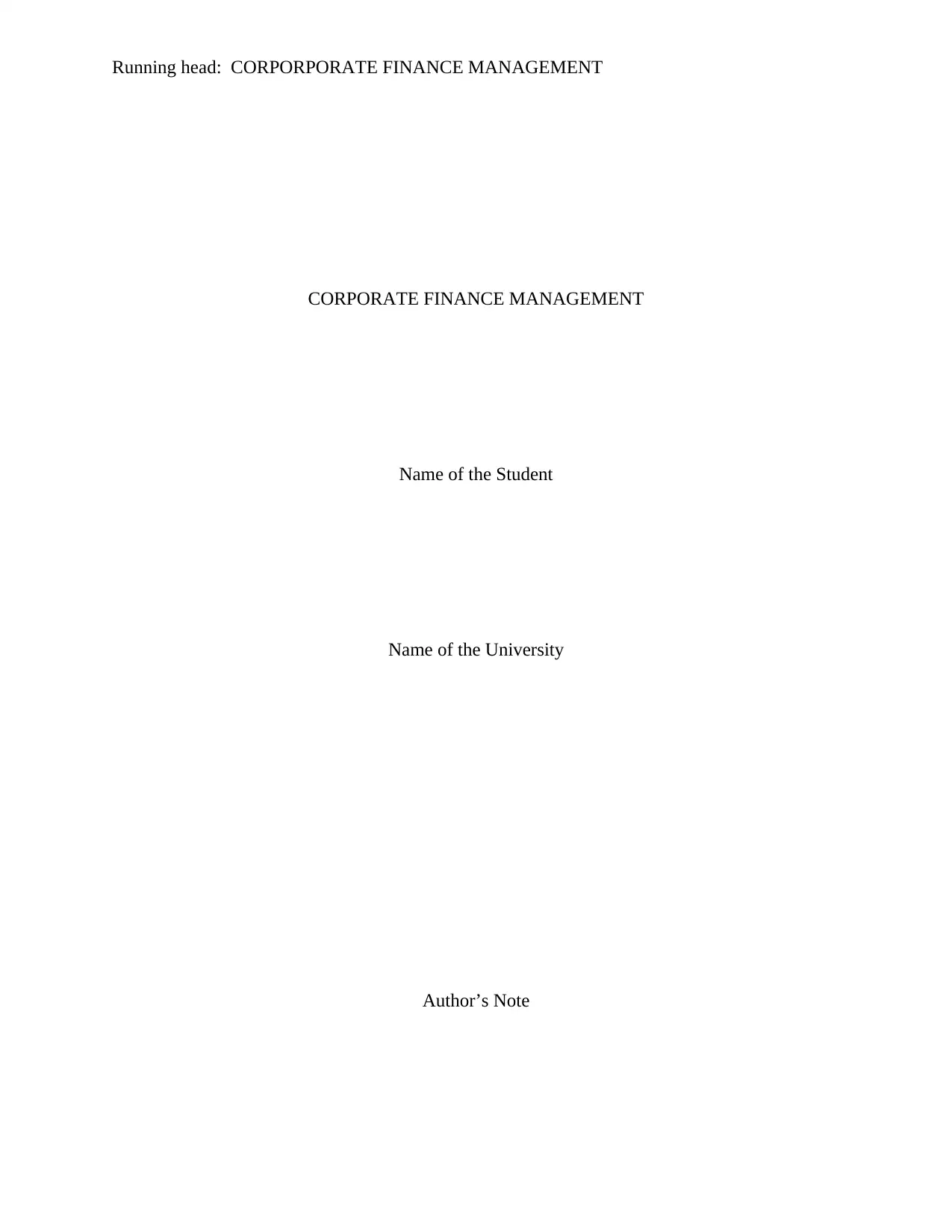
Running head: CORPORPORATE FINANCE MANAGEMENT
CORPORATE FINANCE MANAGEMENT
Name of the Student
Name of the University
Author’s Note
CORPORATE FINANCE MANAGEMENT
Name of the Student
Name of the University
Author’s Note
Secure Best Marks with AI Grader
Need help grading? Try our AI Grader for instant feedback on your assignments.
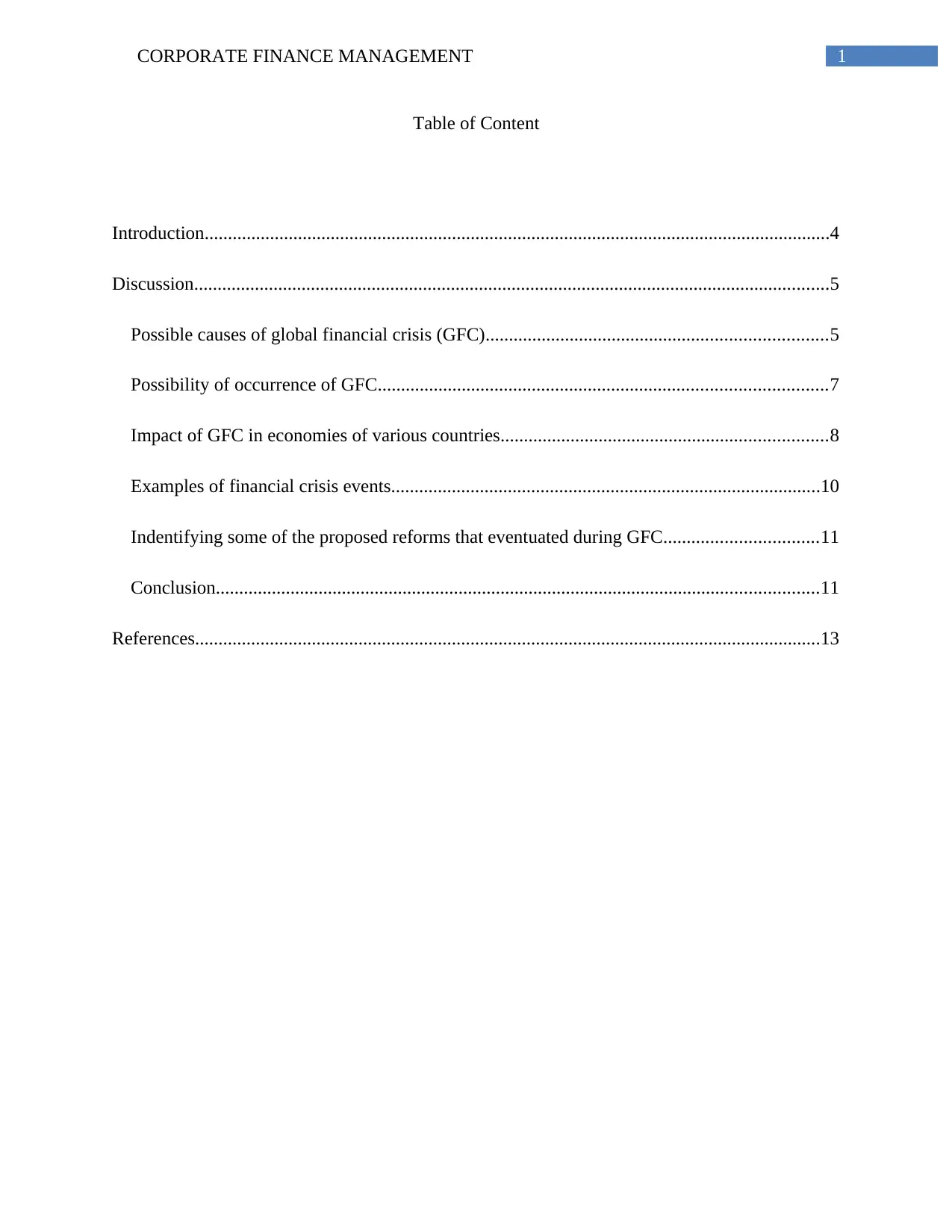
1CORPORATE FINANCE MANAGEMENT
Table of Content
Introduction......................................................................................................................................4
Discussion........................................................................................................................................5
Possible causes of global financial crisis (GFC).........................................................................5
Possibility of occurrence of GFC................................................................................................7
Impact of GFC in economies of various countries......................................................................8
Examples of financial crisis events............................................................................................10
Indentifying some of the proposed reforms that eventuated during GFC.................................11
Conclusion.................................................................................................................................11
References......................................................................................................................................13
Table of Content
Introduction......................................................................................................................................4
Discussion........................................................................................................................................5
Possible causes of global financial crisis (GFC).........................................................................5
Possibility of occurrence of GFC................................................................................................7
Impact of GFC in economies of various countries......................................................................8
Examples of financial crisis events............................................................................................10
Indentifying some of the proposed reforms that eventuated during GFC.................................11
Conclusion.................................................................................................................................11
References......................................................................................................................................13

2CORPORATE FINANCE MANAGEMENT
Introduction
The assignment provides an overview about the causes and impact of global financial
crisis (GFC) among various countries. The study also focuses on the examples of the GFC
events that occurred during this period. The financial crisis during the period 2007-2008, also
termed as GFC and is also considered as the worst crisis since the occurrence of great depression
of 1929. It is the most significant economic catastrophe that adversely influenced several
countries in the world (Ait-Sahalia et al. 2012). This crisis started in the year 2007 with the
subprime mortgage crisis in the US, which further developed into international banking crisis
along with collapse of investment bank named as Lehman Brothers. Owing to this subprime
mortgage crisis, several investors in US lost their confidence in making their investment in
business, which in turn caused liquidity crisis. This GFC had also worsened owing to crash and
high volatility of the stock market. In fact, huge bail out of the financial organizations and other
monetary as well as fiscal policies had been integrated by the policymakers in order to prevent
collapse of the global financial system (Berkmen et al. 2012). This global crisis was followed by
the economic downturn also known as Great Recession. In fact, the individuals having fear of
their wealth also contributed to this GFC by demanding that the financial institutions as well as
banks repay their money as much as possible. By meeting the demand of customers causes these
banks to liquidate financial assets holdings. In fact, some of the reforms that eventuated during
this period are also highlighted in this study.
Introduction
The assignment provides an overview about the causes and impact of global financial
crisis (GFC) among various countries. The study also focuses on the examples of the GFC
events that occurred during this period. The financial crisis during the period 2007-2008, also
termed as GFC and is also considered as the worst crisis since the occurrence of great depression
of 1929. It is the most significant economic catastrophe that adversely influenced several
countries in the world (Ait-Sahalia et al. 2012). This crisis started in the year 2007 with the
subprime mortgage crisis in the US, which further developed into international banking crisis
along with collapse of investment bank named as Lehman Brothers. Owing to this subprime
mortgage crisis, several investors in US lost their confidence in making their investment in
business, which in turn caused liquidity crisis. This GFC had also worsened owing to crash and
high volatility of the stock market. In fact, huge bail out of the financial organizations and other
monetary as well as fiscal policies had been integrated by the policymakers in order to prevent
collapse of the global financial system (Berkmen et al. 2012). This global crisis was followed by
the economic downturn also known as Great Recession. In fact, the individuals having fear of
their wealth also contributed to this GFC by demanding that the financial institutions as well as
banks repay their money as much as possible. By meeting the demand of customers causes these
banks to liquidate financial assets holdings. In fact, some of the reforms that eventuated during
this period are also highlighted in this study.
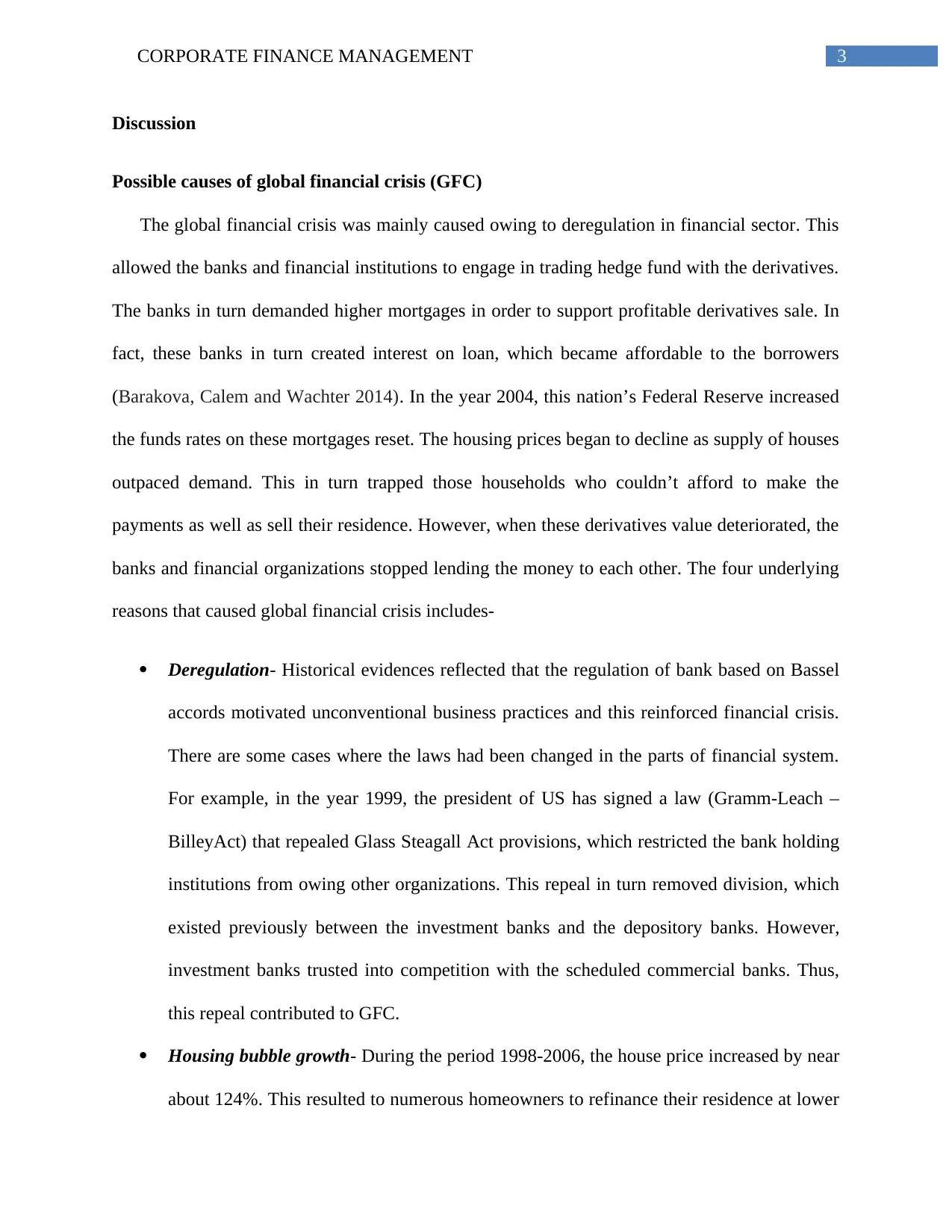
3CORPORATE FINANCE MANAGEMENT
Discussion
Possible causes of global financial crisis (GFC)
The global financial crisis was mainly caused owing to deregulation in financial sector. This
allowed the banks and financial institutions to engage in trading hedge fund with the derivatives.
The banks in turn demanded higher mortgages in order to support profitable derivatives sale. In
fact, these banks in turn created interest on loan, which became affordable to the borrowers
(Barakova, Calem and Wachter 2014). In the year 2004, this nation’s Federal Reserve increased
the funds rates on these mortgages reset. The housing prices began to decline as supply of houses
outpaced demand. This in turn trapped those households who couldn’t afford to make the
payments as well as sell their residence. However, when these derivatives value deteriorated, the
banks and financial organizations stopped lending the money to each other. The four underlying
reasons that caused global financial crisis includes-
Deregulation- Historical evidences reflected that the regulation of bank based on Bassel
accords motivated unconventional business practices and this reinforced financial crisis.
There are some cases where the laws had been changed in the parts of financial system.
For example, in the year 1999, the president of US has signed a law (Gramm-Leach –
BilleyAct) that repealed Glass Steagall Act provisions, which restricted the bank holding
institutions from owing other organizations. This repeal in turn removed division, which
existed previously between the investment banks and the depository banks. However,
investment banks trusted into competition with the scheduled commercial banks. Thus,
this repeal contributed to GFC.
Housing bubble growth- During the period 1998-2006, the house price increased by near
about 124%. This resulted to numerous homeowners to refinance their residence at lower
Discussion
Possible causes of global financial crisis (GFC)
The global financial crisis was mainly caused owing to deregulation in financial sector. This
allowed the banks and financial institutions to engage in trading hedge fund with the derivatives.
The banks in turn demanded higher mortgages in order to support profitable derivatives sale. In
fact, these banks in turn created interest on loan, which became affordable to the borrowers
(Barakova, Calem and Wachter 2014). In the year 2004, this nation’s Federal Reserve increased
the funds rates on these mortgages reset. The housing prices began to decline as supply of houses
outpaced demand. This in turn trapped those households who couldn’t afford to make the
payments as well as sell their residence. However, when these derivatives value deteriorated, the
banks and financial organizations stopped lending the money to each other. The four underlying
reasons that caused global financial crisis includes-
Deregulation- Historical evidences reflected that the regulation of bank based on Bassel
accords motivated unconventional business practices and this reinforced financial crisis.
There are some cases where the laws had been changed in the parts of financial system.
For example, in the year 1999, the president of US has signed a law (Gramm-Leach –
BilleyAct) that repealed Glass Steagall Act provisions, which restricted the bank holding
institutions from owing other organizations. This repeal in turn removed division, which
existed previously between the investment banks and the depository banks. However,
investment banks trusted into competition with the scheduled commercial banks. Thus,
this repeal contributed to GFC.
Housing bubble growth- During the period 1998-2006, the house price increased by near
about 124%. This resulted to numerous homeowners to refinance their residence at lower
Secure Best Marks with AI Grader
Need help grading? Try our AI Grader for instant feedback on your assignments.

4CORPORATE FINANCE MANAGEMENT
rate of interest or financing consumer expenditure by taking mortgages (Cheng, Raina
and Xiong 2012). The huge amount of money sought higher yields than that offered by
treasury bonds. The investment banks connected this money to this nation’s mortgage
market. In the year 2003, the mortgage supply exhausted and hence huge demand
reducing lending standards. By the year 2008, this housing prices declined by 20% and
hence borrowers face difficulty to refinance for avoiding higher payments relating to
higher interest rates. Hence, all outstanding mortgages became delinquent.
Easier credit conditions- Low rate of interest in banks encouraged borrowing. During the
period 2000-2003, the US Federal Reserve decreased their funds rate from 6.5% to 1%.
However, in the year 2002, it was seen that this credit conditions was fueling housing
rather than business investment (Haas and Lelyveld 2014). Moreover, rising current
account deficit created downward pressure on banks interest rate. This deficit in current
account increased by around $650 billion and hence recovering this deficit required them
to borrow money from other nation. Huge amount of capital reached this financial market
and hence US households utilized these funds borrowed from foreigners for financing
consumption. However, Fed increased funds rate in the year 2006, which in turn
increased adjustable rate mortgage (ARM) rates.
Predatory lending- This refers to as the unscrupulous lenders practice that entice
borrowers to move into unsafe secured loans for bad purposes. The US banks provided
loans to several borrowers who have taken money for unfair business practices. However,
this deteriorated financial condition of this nation.
rate of interest or financing consumer expenditure by taking mortgages (Cheng, Raina
and Xiong 2012). The huge amount of money sought higher yields than that offered by
treasury bonds. The investment banks connected this money to this nation’s mortgage
market. In the year 2003, the mortgage supply exhausted and hence huge demand
reducing lending standards. By the year 2008, this housing prices declined by 20% and
hence borrowers face difficulty to refinance for avoiding higher payments relating to
higher interest rates. Hence, all outstanding mortgages became delinquent.
Easier credit conditions- Low rate of interest in banks encouraged borrowing. During the
period 2000-2003, the US Federal Reserve decreased their funds rate from 6.5% to 1%.
However, in the year 2002, it was seen that this credit conditions was fueling housing
rather than business investment (Haas and Lelyveld 2014). Moreover, rising current
account deficit created downward pressure on banks interest rate. This deficit in current
account increased by around $650 billion and hence recovering this deficit required them
to borrow money from other nation. Huge amount of capital reached this financial market
and hence US households utilized these funds borrowed from foreigners for financing
consumption. However, Fed increased funds rate in the year 2006, which in turn
increased adjustable rate mortgage (ARM) rates.
Predatory lending- This refers to as the unscrupulous lenders practice that entice
borrowers to move into unsafe secured loans for bad purposes. The US banks provided
loans to several borrowers who have taken money for unfair business practices. However,
this deteriorated financial condition of this nation.
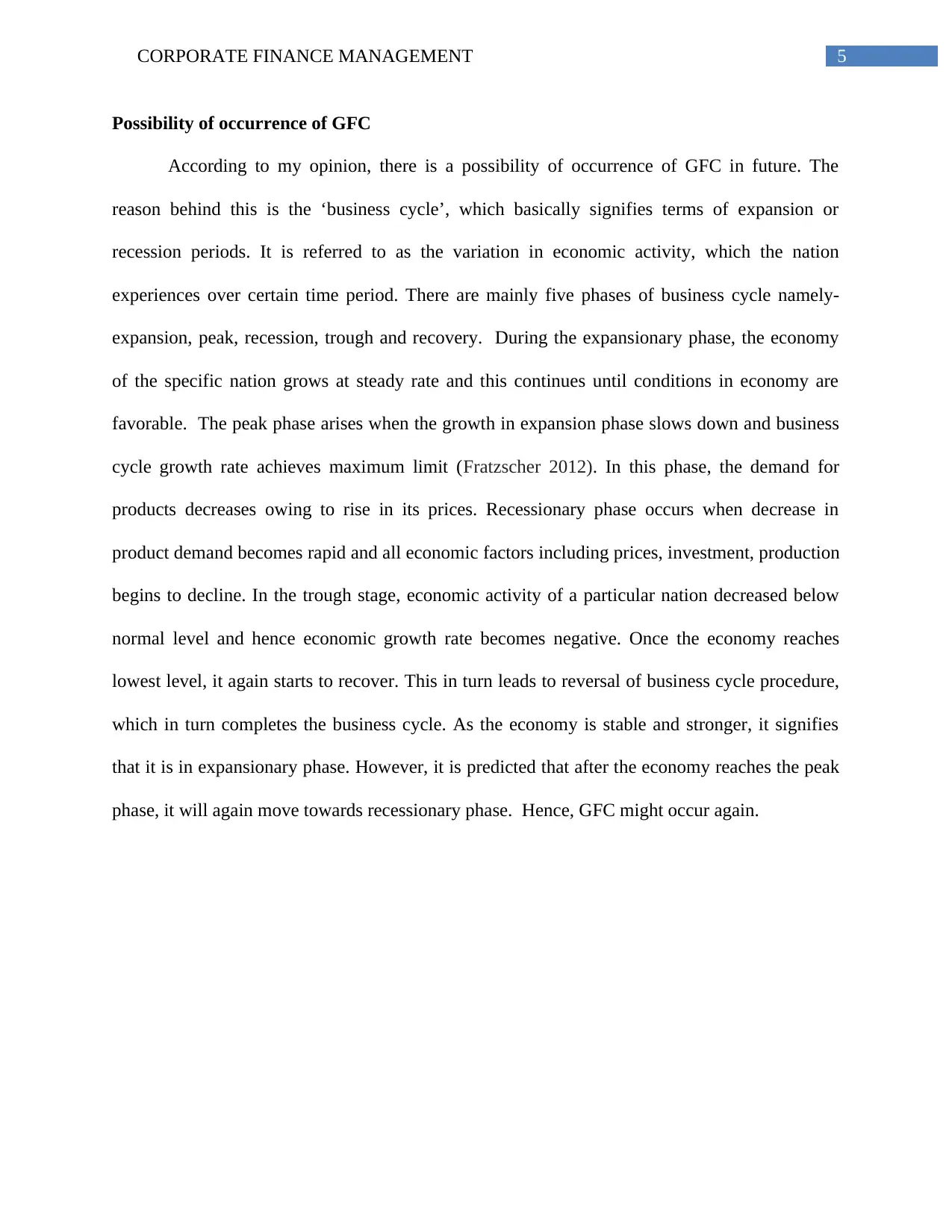
5CORPORATE FINANCE MANAGEMENT
Possibility of occurrence of GFC
According to my opinion, there is a possibility of occurrence of GFC in future. The
reason behind this is the ‘business cycle’, which basically signifies terms of expansion or
recession periods. It is referred to as the variation in economic activity, which the nation
experiences over certain time period. There are mainly five phases of business cycle namely-
expansion, peak, recession, trough and recovery. During the expansionary phase, the economy
of the specific nation grows at steady rate and this continues until conditions in economy are
favorable. The peak phase arises when the growth in expansion phase slows down and business
cycle growth rate achieves maximum limit (Fratzscher 2012). In this phase, the demand for
products decreases owing to rise in its prices. Recessionary phase occurs when decrease in
product demand becomes rapid and all economic factors including prices, investment, production
begins to decline. In the trough stage, economic activity of a particular nation decreased below
normal level and hence economic growth rate becomes negative. Once the economy reaches
lowest level, it again starts to recover. This in turn leads to reversal of business cycle procedure,
which in turn completes the business cycle. As the economy is stable and stronger, it signifies
that it is in expansionary phase. However, it is predicted that after the economy reaches the peak
phase, it will again move towards recessionary phase. Hence, GFC might occur again.
Possibility of occurrence of GFC
According to my opinion, there is a possibility of occurrence of GFC in future. The
reason behind this is the ‘business cycle’, which basically signifies terms of expansion or
recession periods. It is referred to as the variation in economic activity, which the nation
experiences over certain time period. There are mainly five phases of business cycle namely-
expansion, peak, recession, trough and recovery. During the expansionary phase, the economy
of the specific nation grows at steady rate and this continues until conditions in economy are
favorable. The peak phase arises when the growth in expansion phase slows down and business
cycle growth rate achieves maximum limit (Fratzscher 2012). In this phase, the demand for
products decreases owing to rise in its prices. Recessionary phase occurs when decrease in
product demand becomes rapid and all economic factors including prices, investment, production
begins to decline. In the trough stage, economic activity of a particular nation decreased below
normal level and hence economic growth rate becomes negative. Once the economy reaches
lowest level, it again starts to recover. This in turn leads to reversal of business cycle procedure,
which in turn completes the business cycle. As the economy is stable and stronger, it signifies
that it is in expansionary phase. However, it is predicted that after the economy reaches the peak
phase, it will again move towards recessionary phase. Hence, GFC might occur again.
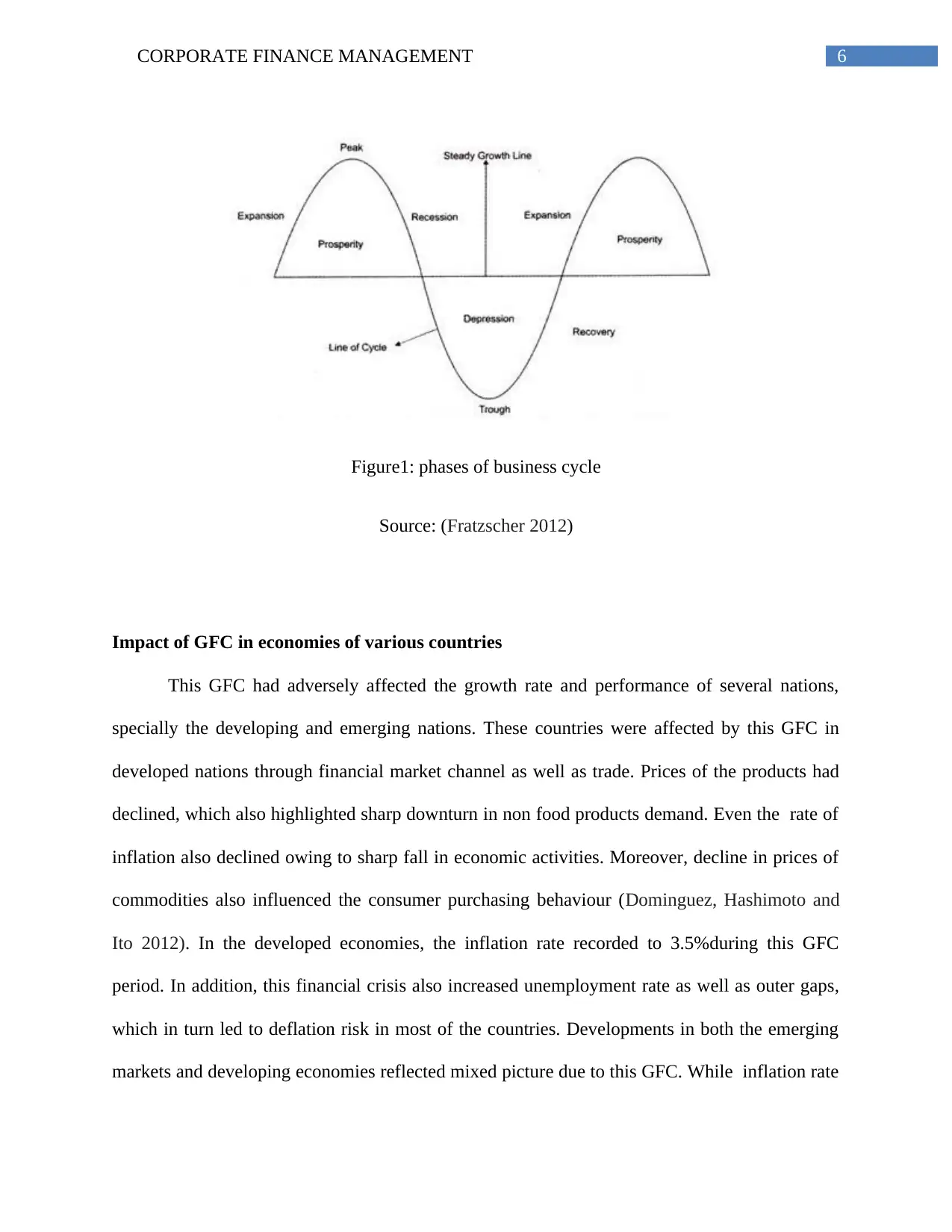
6CORPORATE FINANCE MANAGEMENT
Figure1: phases of business cycle
Source: (Fratzscher 2012)
Impact of GFC in economies of various countries
This GFC had adversely affected the growth rate and performance of several nations,
specially the developing and emerging nations. These countries were affected by this GFC in
developed nations through financial market channel as well as trade. Prices of the products had
declined, which also highlighted sharp downturn in non food products demand. Even the rate of
inflation also declined owing to sharp fall in economic activities. Moreover, decline in prices of
commodities also influenced the consumer purchasing behaviour (Dominguez, Hashimoto and
Ito 2012). In the developed economies, the inflation rate recorded to 3.5%during this GFC
period. In addition, this financial crisis also increased unemployment rate as well as outer gaps,
which in turn led to deflation risk in most of the countries. Developments in both the emerging
markets and developing economies reflected mixed picture due to this GFC. While inflation rate
Figure1: phases of business cycle
Source: (Fratzscher 2012)
Impact of GFC in economies of various countries
This GFC had adversely affected the growth rate and performance of several nations,
specially the developing and emerging nations. These countries were affected by this GFC in
developed nations through financial market channel as well as trade. Prices of the products had
declined, which also highlighted sharp downturn in non food products demand. Even the rate of
inflation also declined owing to sharp fall in economic activities. Moreover, decline in prices of
commodities also influenced the consumer purchasing behaviour (Dominguez, Hashimoto and
Ito 2012). In the developed economies, the inflation rate recorded to 3.5%during this GFC
period. In addition, this financial crisis also increased unemployment rate as well as outer gaps,
which in turn led to deflation risk in most of the countries. Developments in both the emerging
markets and developing economies reflected mixed picture due to this GFC. While inflation rate
Paraphrase This Document
Need a fresh take? Get an instant paraphrase of this document with our AI Paraphraser
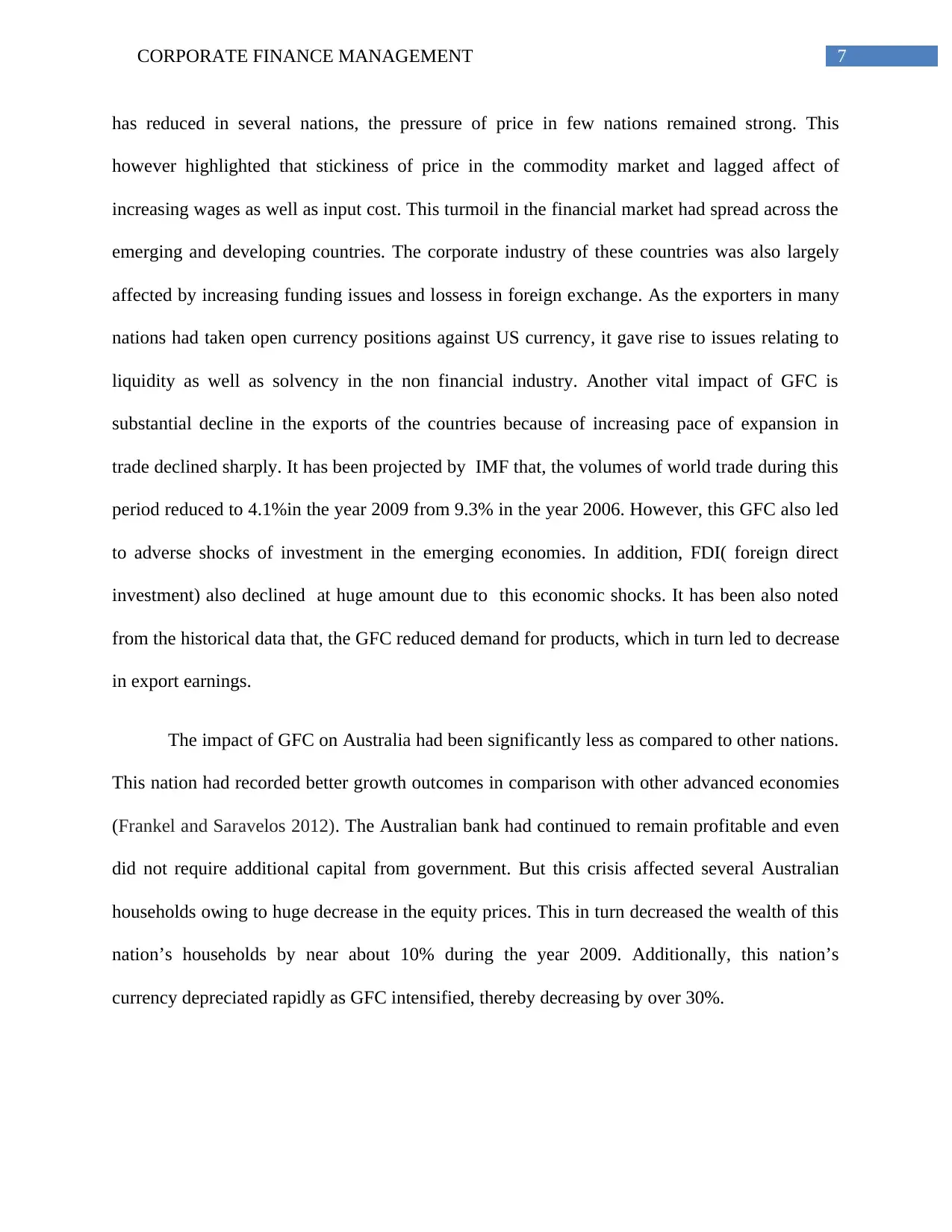
7CORPORATE FINANCE MANAGEMENT
has reduced in several nations, the pressure of price in few nations remained strong. This
however highlighted that stickiness of price in the commodity market and lagged affect of
increasing wages as well as input cost. This turmoil in the financial market had spread across the
emerging and developing countries. The corporate industry of these countries was also largely
affected by increasing funding issues and lossess in foreign exchange. As the exporters in many
nations had taken open currency positions against US currency, it gave rise to issues relating to
liquidity as well as solvency in the non financial industry. Another vital impact of GFC is
substantial decline in the exports of the countries because of increasing pace of expansion in
trade declined sharply. It has been projected by IMF that, the volumes of world trade during this
period reduced to 4.1%in the year 2009 from 9.3% in the year 2006. However, this GFC also led
to adverse shocks of investment in the emerging economies. In addition, FDI( foreign direct
investment) also declined at huge amount due to this economic shocks. It has been also noted
from the historical data that, the GFC reduced demand for products, which in turn led to decrease
in export earnings.
The impact of GFC on Australia had been significantly less as compared to other nations.
This nation had recorded better growth outcomes in comparison with other advanced economies
(Frankel and Saravelos 2012). The Australian bank had continued to remain profitable and even
did not require additional capital from government. But this crisis affected several Australian
households owing to huge decrease in the equity prices. This in turn decreased the wealth of this
nation’s households by near about 10% during the year 2009. Additionally, this nation’s
currency depreciated rapidly as GFC intensified, thereby decreasing by over 30%.
has reduced in several nations, the pressure of price in few nations remained strong. This
however highlighted that stickiness of price in the commodity market and lagged affect of
increasing wages as well as input cost. This turmoil in the financial market had spread across the
emerging and developing countries. The corporate industry of these countries was also largely
affected by increasing funding issues and lossess in foreign exchange. As the exporters in many
nations had taken open currency positions against US currency, it gave rise to issues relating to
liquidity as well as solvency in the non financial industry. Another vital impact of GFC is
substantial decline in the exports of the countries because of increasing pace of expansion in
trade declined sharply. It has been projected by IMF that, the volumes of world trade during this
period reduced to 4.1%in the year 2009 from 9.3% in the year 2006. However, this GFC also led
to adverse shocks of investment in the emerging economies. In addition, FDI( foreign direct
investment) also declined at huge amount due to this economic shocks. It has been also noted
from the historical data that, the GFC reduced demand for products, which in turn led to decrease
in export earnings.
The impact of GFC on Australia had been significantly less as compared to other nations.
This nation had recorded better growth outcomes in comparison with other advanced economies
(Frankel and Saravelos 2012). The Australian bank had continued to remain profitable and even
did not require additional capital from government. But this crisis affected several Australian
households owing to huge decrease in the equity prices. This in turn decreased the wealth of this
nation’s households by near about 10% during the year 2009. Additionally, this nation’s
currency depreciated rapidly as GFC intensified, thereby decreasing by over 30%.

8CORPORATE FINANCE MANAGEMENT
Examples of financial crisis events
Subprime mortgages crisis- The subprime mortgage crisis was mainly triggered by huge
decline in prices of residence after the crumple of housing bubble. This lead to mortgage
delinquencies and devaluation of securities relaying to housing (Brueckner, Calem and
Nakamura 2012) There were several reasons of this crisis, out of which subprime lending
and rise in speculation of housing were two proximate reasons. Other causes includes –
homeowners inability to make mortgage payments, risky mortgage goods, high level of
corporate as well as personal debt, bad housing policies, imbalances in international trade
and improper regulation of government of this nation.
Collapse of Lehman Brothers- During the GFC, Lehman Brothers was filed for
bankruptcy. With more than $639 billion in total assets and $619 billion in debt, this
investment bank collapsed as their assets surpassed that of the bankrupt giants. This
seminal event had contributed to erosion of $10 trillion in the capitalization of market
from the world equity markets. Eruption of credit crisis with failure of hedge funds, the
stock process of this investment bank fell sharply. During that period, this bank
eliminated more than 2500 mortgage related jobs and also shut down their BNC unit. In
the last quarter of 2007, their stock rebounded as the world equity market had reached at
new height and their fixed income assets prices took temporary rebound (Cukierman
2013). Their high level of leverage as well as huge mortgage securities portfolio made it
vulnerable to the market conditions. However, their shares fell to near about 48% and
hence led to collapse.
Examples of financial crisis events
Subprime mortgages crisis- The subprime mortgage crisis was mainly triggered by huge
decline in prices of residence after the crumple of housing bubble. This lead to mortgage
delinquencies and devaluation of securities relaying to housing (Brueckner, Calem and
Nakamura 2012) There were several reasons of this crisis, out of which subprime lending
and rise in speculation of housing were two proximate reasons. Other causes includes –
homeowners inability to make mortgage payments, risky mortgage goods, high level of
corporate as well as personal debt, bad housing policies, imbalances in international trade
and improper regulation of government of this nation.
Collapse of Lehman Brothers- During the GFC, Lehman Brothers was filed for
bankruptcy. With more than $639 billion in total assets and $619 billion in debt, this
investment bank collapsed as their assets surpassed that of the bankrupt giants. This
seminal event had contributed to erosion of $10 trillion in the capitalization of market
from the world equity markets. Eruption of credit crisis with failure of hedge funds, the
stock process of this investment bank fell sharply. During that period, this bank
eliminated more than 2500 mortgage related jobs and also shut down their BNC unit. In
the last quarter of 2007, their stock rebounded as the world equity market had reached at
new height and their fixed income assets prices took temporary rebound (Cukierman
2013). Their high level of leverage as well as huge mortgage securities portfolio made it
vulnerable to the market conditions. However, their shares fell to near about 48% and
hence led to collapse.
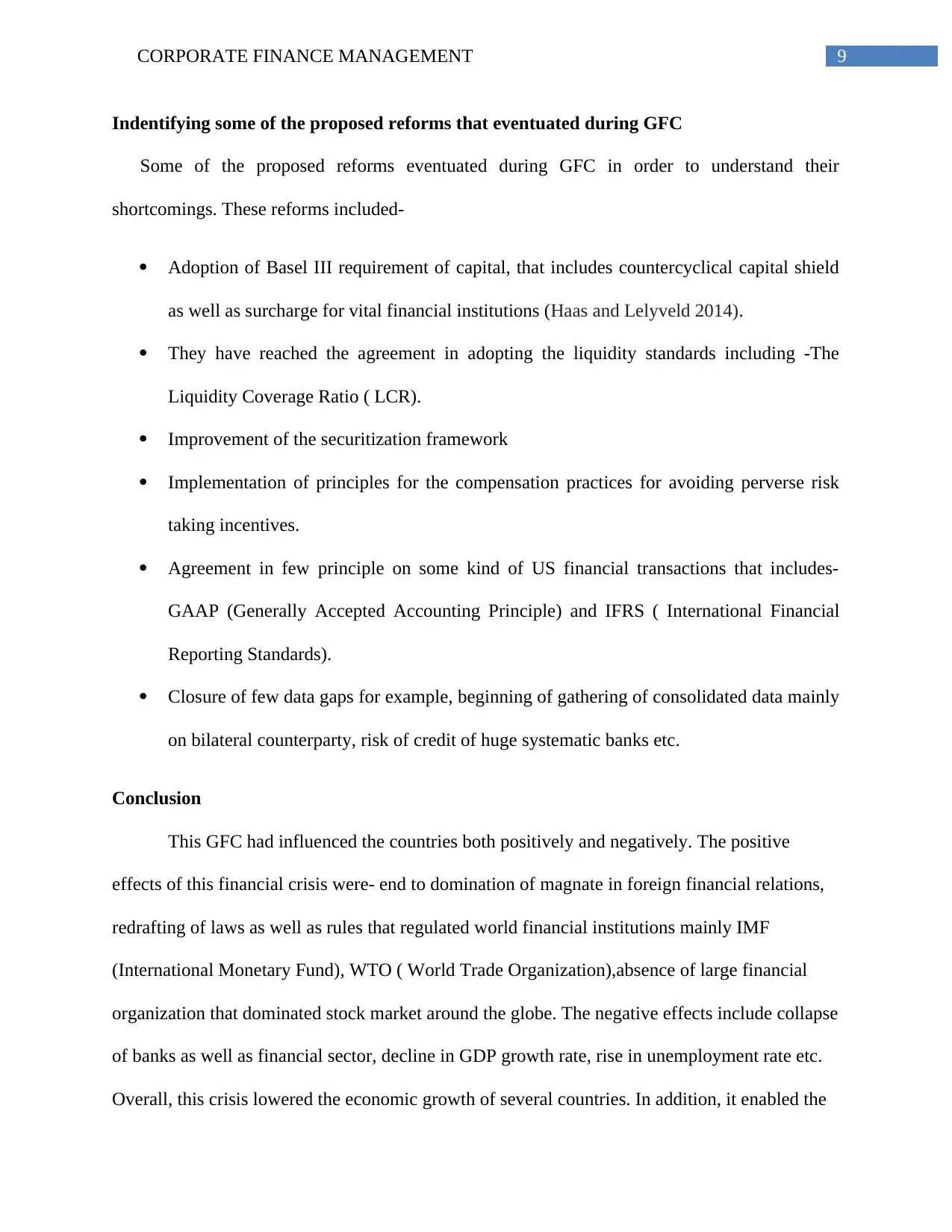
9CORPORATE FINANCE MANAGEMENT
Indentifying some of the proposed reforms that eventuated during GFC
Some of the proposed reforms eventuated during GFC in order to understand their
shortcomings. These reforms included-
Adoption of Basel III requirement of capital, that includes countercyclical capital shield
as well as surcharge for vital financial institutions (Haas and Lelyveld 2014).
They have reached the agreement in adopting the liquidity standards including -The
Liquidity Coverage Ratio ( LCR).
Improvement of the securitization framework
Implementation of principles for the compensation practices for avoiding perverse risk
taking incentives.
Agreement in few principle on some kind of US financial transactions that includes-
GAAP (Generally Accepted Accounting Principle) and IFRS ( International Financial
Reporting Standards).
Closure of few data gaps for example, beginning of gathering of consolidated data mainly
on bilateral counterparty, risk of credit of huge systematic banks etc.
Conclusion
This GFC had influenced the countries both positively and negatively. The positive
effects of this financial crisis were- end to domination of magnate in foreign financial relations,
redrafting of laws as well as rules that regulated world financial institutions mainly IMF
(International Monetary Fund), WTO ( World Trade Organization),absence of large financial
organization that dominated stock market around the globe. The negative effects include collapse
of banks as well as financial sector, decline in GDP growth rate, rise in unemployment rate etc.
Overall, this crisis lowered the economic growth of several countries. In addition, it enabled the
Indentifying some of the proposed reforms that eventuated during GFC
Some of the proposed reforms eventuated during GFC in order to understand their
shortcomings. These reforms included-
Adoption of Basel III requirement of capital, that includes countercyclical capital shield
as well as surcharge for vital financial institutions (Haas and Lelyveld 2014).
They have reached the agreement in adopting the liquidity standards including -The
Liquidity Coverage Ratio ( LCR).
Improvement of the securitization framework
Implementation of principles for the compensation practices for avoiding perverse risk
taking incentives.
Agreement in few principle on some kind of US financial transactions that includes-
GAAP (Generally Accepted Accounting Principle) and IFRS ( International Financial
Reporting Standards).
Closure of few data gaps for example, beginning of gathering of consolidated data mainly
on bilateral counterparty, risk of credit of huge systematic banks etc.
Conclusion
This GFC had influenced the countries both positively and negatively. The positive
effects of this financial crisis were- end to domination of magnate in foreign financial relations,
redrafting of laws as well as rules that regulated world financial institutions mainly IMF
(International Monetary Fund), WTO ( World Trade Organization),absence of large financial
organization that dominated stock market around the globe. The negative effects include collapse
of banks as well as financial sector, decline in GDP growth rate, rise in unemployment rate etc.
Overall, this crisis lowered the economic growth of several countries. In addition, it enabled the
Secure Best Marks with AI Grader
Need help grading? Try our AI Grader for instant feedback on your assignments.
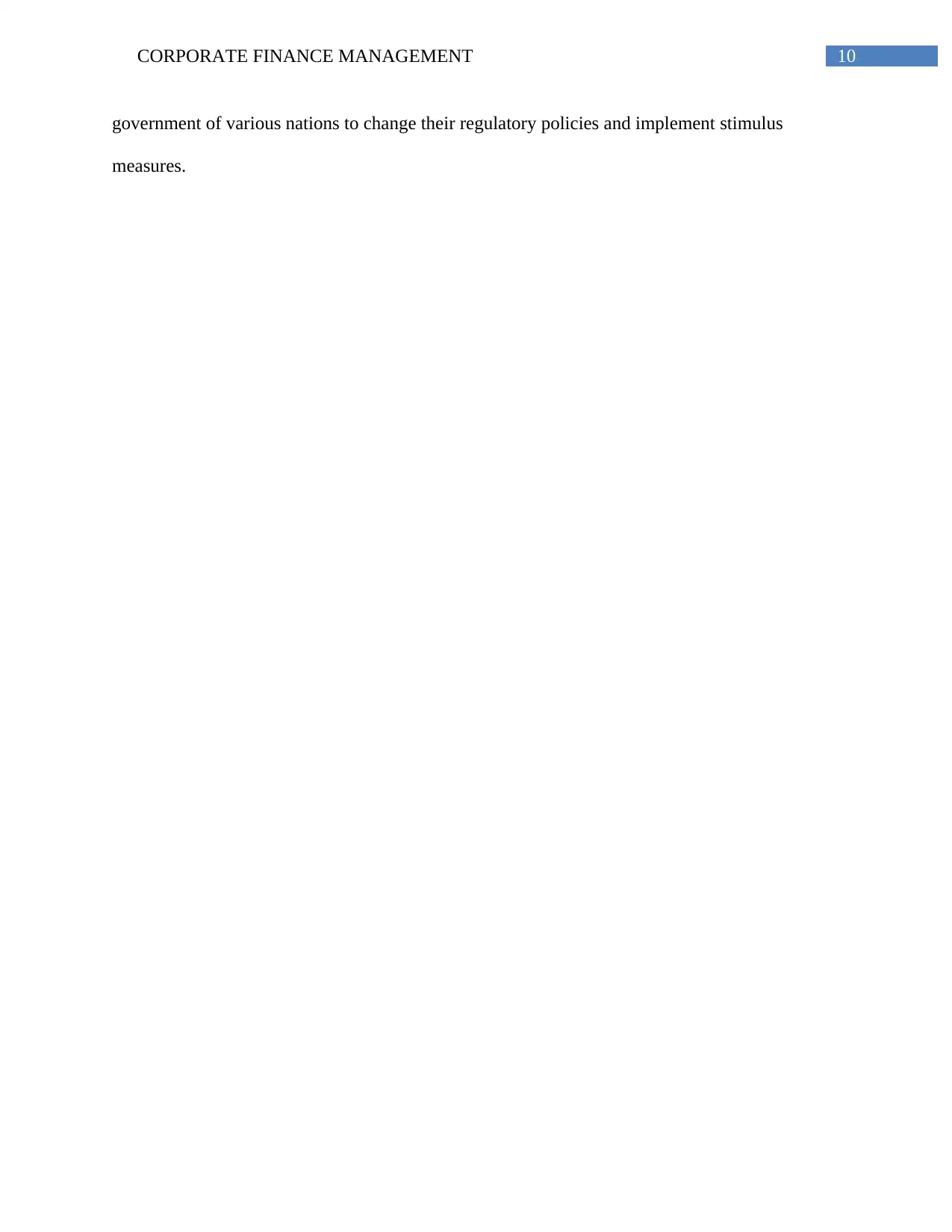
10CORPORATE FINANCE MANAGEMENT
government of various nations to change their regulatory policies and implement stimulus
measures.
government of various nations to change their regulatory policies and implement stimulus
measures.
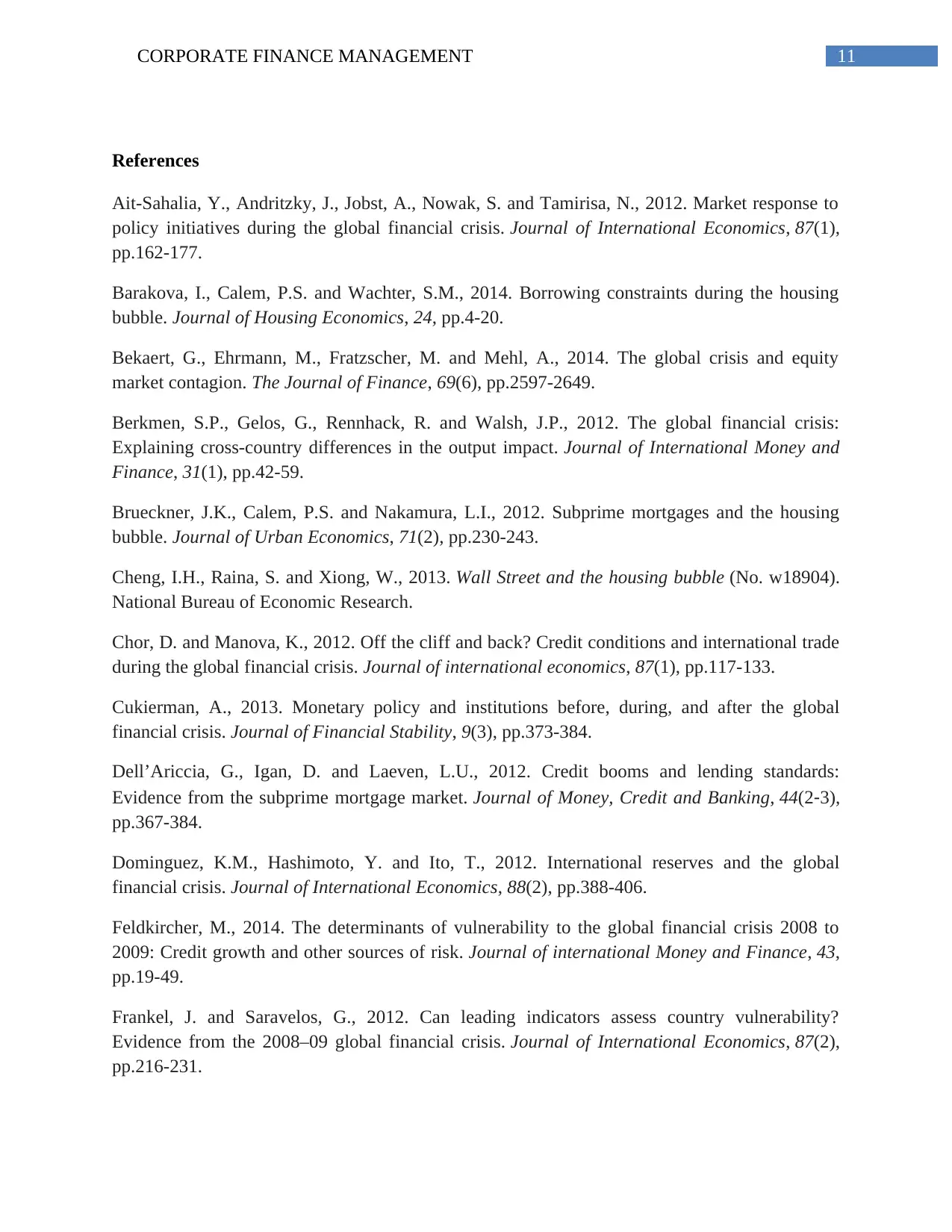
11CORPORATE FINANCE MANAGEMENT
References
Ait-Sahalia, Y., Andritzky, J., Jobst, A., Nowak, S. and Tamirisa, N., 2012. Market response to
policy initiatives during the global financial crisis. Journal of International Economics, 87(1),
pp.162-177.
Barakova, I., Calem, P.S. and Wachter, S.M., 2014. Borrowing constraints during the housing
bubble. Journal of Housing Economics, 24, pp.4-20.
Bekaert, G., Ehrmann, M., Fratzscher, M. and Mehl, A., 2014. The global crisis and equity
market contagion. The Journal of Finance, 69(6), pp.2597-2649.
Berkmen, S.P., Gelos, G., Rennhack, R. and Walsh, J.P., 2012. The global financial crisis:
Explaining cross-country differences in the output impact. Journal of International Money and
Finance, 31(1), pp.42-59.
Brueckner, J.K., Calem, P.S. and Nakamura, L.I., 2012. Subprime mortgages and the housing
bubble. Journal of Urban Economics, 71(2), pp.230-243.
Cheng, I.H., Raina, S. and Xiong, W., 2013. Wall Street and the housing bubble (No. w18904).
National Bureau of Economic Research.
Chor, D. and Manova, K., 2012. Off the cliff and back? Credit conditions and international trade
during the global financial crisis. Journal of international economics, 87(1), pp.117-133.
Cukierman, A., 2013. Monetary policy and institutions before, during, and after the global
financial crisis. Journal of Financial Stability, 9(3), pp.373-384.
Dell’Ariccia, G., Igan, D. and Laeven, L.U., 2012. Credit booms and lending standards:
Evidence from the subprime mortgage market. Journal of Money, Credit and Banking, 44(2‐3),
pp.367-384.
Dominguez, K.M., Hashimoto, Y. and Ito, T., 2012. International reserves and the global
financial crisis. Journal of International Economics, 88(2), pp.388-406.
Feldkircher, M., 2014. The determinants of vulnerability to the global financial crisis 2008 to
2009: Credit growth and other sources of risk. Journal of international Money and Finance, 43,
pp.19-49.
Frankel, J. and Saravelos, G., 2012. Can leading indicators assess country vulnerability?
Evidence from the 2008–09 global financial crisis. Journal of International Economics, 87(2),
pp.216-231.
References
Ait-Sahalia, Y., Andritzky, J., Jobst, A., Nowak, S. and Tamirisa, N., 2012. Market response to
policy initiatives during the global financial crisis. Journal of International Economics, 87(1),
pp.162-177.
Barakova, I., Calem, P.S. and Wachter, S.M., 2014. Borrowing constraints during the housing
bubble. Journal of Housing Economics, 24, pp.4-20.
Bekaert, G., Ehrmann, M., Fratzscher, M. and Mehl, A., 2014. The global crisis and equity
market contagion. The Journal of Finance, 69(6), pp.2597-2649.
Berkmen, S.P., Gelos, G., Rennhack, R. and Walsh, J.P., 2012. The global financial crisis:
Explaining cross-country differences in the output impact. Journal of International Money and
Finance, 31(1), pp.42-59.
Brueckner, J.K., Calem, P.S. and Nakamura, L.I., 2012. Subprime mortgages and the housing
bubble. Journal of Urban Economics, 71(2), pp.230-243.
Cheng, I.H., Raina, S. and Xiong, W., 2013. Wall Street and the housing bubble (No. w18904).
National Bureau of Economic Research.
Chor, D. and Manova, K., 2012. Off the cliff and back? Credit conditions and international trade
during the global financial crisis. Journal of international economics, 87(1), pp.117-133.
Cukierman, A., 2013. Monetary policy and institutions before, during, and after the global
financial crisis. Journal of Financial Stability, 9(3), pp.373-384.
Dell’Ariccia, G., Igan, D. and Laeven, L.U., 2012. Credit booms and lending standards:
Evidence from the subprime mortgage market. Journal of Money, Credit and Banking, 44(2‐3),
pp.367-384.
Dominguez, K.M., Hashimoto, Y. and Ito, T., 2012. International reserves and the global
financial crisis. Journal of International Economics, 88(2), pp.388-406.
Feldkircher, M., 2014. The determinants of vulnerability to the global financial crisis 2008 to
2009: Credit growth and other sources of risk. Journal of international Money and Finance, 43,
pp.19-49.
Frankel, J. and Saravelos, G., 2012. Can leading indicators assess country vulnerability?
Evidence from the 2008–09 global financial crisis. Journal of International Economics, 87(2),
pp.216-231.
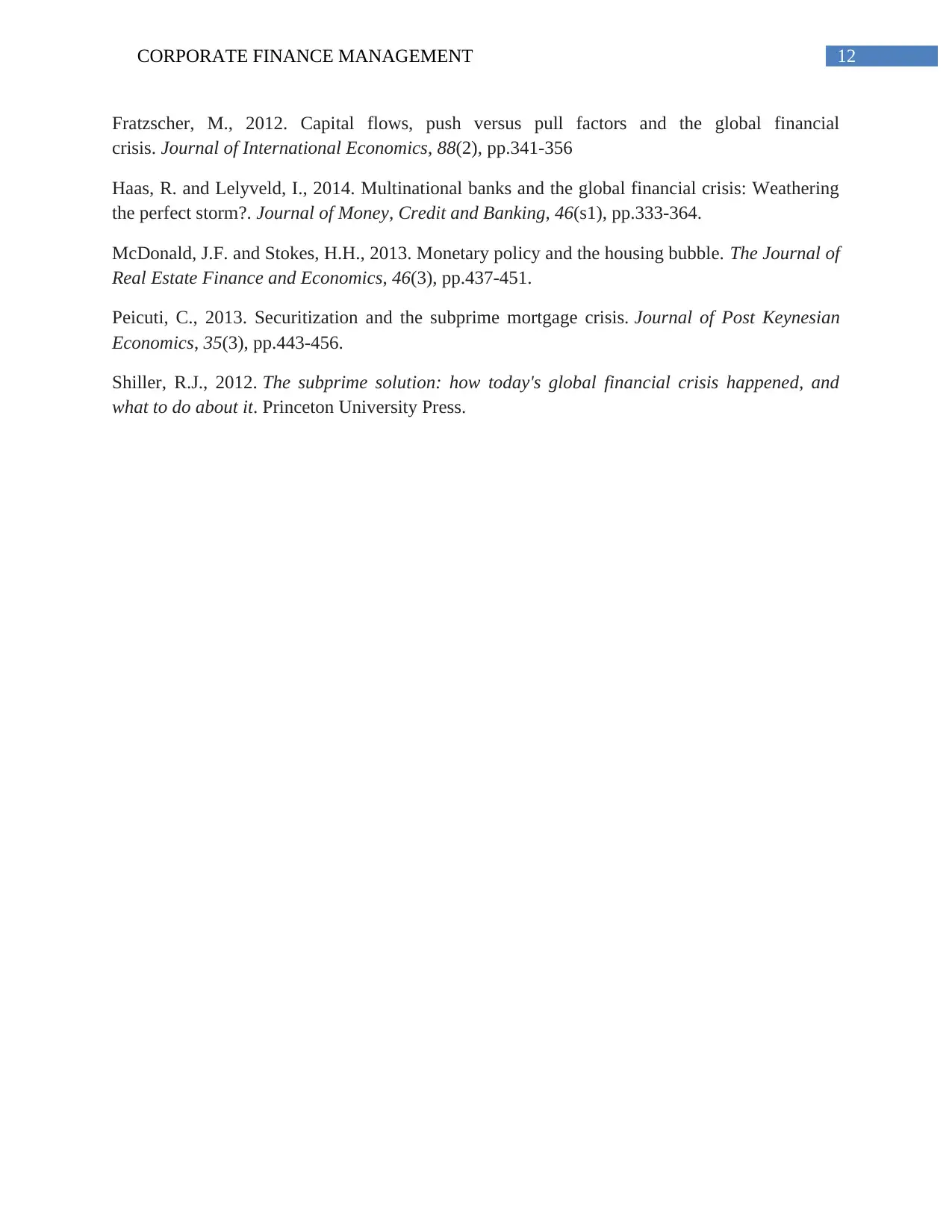
12CORPORATE FINANCE MANAGEMENT
Fratzscher, M., 2012. Capital flows, push versus pull factors and the global financial
crisis. Journal of International Economics, 88(2), pp.341-356
Haas, R. and Lelyveld, I., 2014. Multinational banks and the global financial crisis: Weathering
the perfect storm?. Journal of Money, Credit and Banking, 46(s1), pp.333-364.
McDonald, J.F. and Stokes, H.H., 2013. Monetary policy and the housing bubble. The Journal of
Real Estate Finance and Economics, 46(3), pp.437-451.
Peicuti, C., 2013. Securitization and the subprime mortgage crisis. Journal of Post Keynesian
Economics, 35(3), pp.443-456.
Shiller, R.J., 2012. The subprime solution: how today's global financial crisis happened, and
what to do about it. Princeton University Press.
Fratzscher, M., 2012. Capital flows, push versus pull factors and the global financial
crisis. Journal of International Economics, 88(2), pp.341-356
Haas, R. and Lelyveld, I., 2014. Multinational banks and the global financial crisis: Weathering
the perfect storm?. Journal of Money, Credit and Banking, 46(s1), pp.333-364.
McDonald, J.F. and Stokes, H.H., 2013. Monetary policy and the housing bubble. The Journal of
Real Estate Finance and Economics, 46(3), pp.437-451.
Peicuti, C., 2013. Securitization and the subprime mortgage crisis. Journal of Post Keynesian
Economics, 35(3), pp.443-456.
Shiller, R.J., 2012. The subprime solution: how today's global financial crisis happened, and
what to do about it. Princeton University Press.
1 out of 13
Related Documents
Your All-in-One AI-Powered Toolkit for Academic Success.
+13062052269
info@desklib.com
Available 24*7 on WhatsApp / Email
![[object Object]](/_next/static/media/star-bottom.7253800d.svg)
Unlock your academic potential
© 2024 | Zucol Services PVT LTD | All rights reserved.





